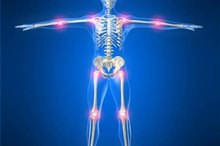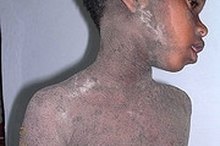First Symptoms of Systemic Scleroderma
Scleroderma is a condition in which a type of connective tissue in the body called collagen is overproduced 1. It can be localized, leading to hardened patches or bands of skin, the tissue that lies immediately below the skin and sometimes the muscles of the arms, legs or forehead. It can also be systemic--sometimes called systemic sclerosis--in which case the excess collagen has a more widespread effect. Systemic scleroderma can be further divided into limited or diffuse categories; the NIH/National Institute of Arthritis and Musculoskeletal and Skin Diseases adds a third category: systemic sclerosis sine, which does not feature the more overt skin changes 12.
Raynaud’s Disease
For all types of sclerosis, Raynaud’s disease is the most common--and frequently the first--symptom, afflicting more than 90 percent of those with scleroderma, according to the Arthritis Foundation 1. This disease, also known as Raynaud’s phenomenon, occurs when the tiny capillary blood vessels in the fingers and toes constrict due to cold temperatures or emotional distress. Toes or fingertips will quickly turn white, then blue; this usually lasts up to 15 minutes. The Mayo Clinic says that the type of Raynaud's phenomenon associated with scleroderma may cause permanent damage to skin on the fingertips 1.
CREST
Autoimmune Lung Diseases
Learn More
This acronym refers to the group of symptoms that may be found to some degree in most cases of limited cutaneous scleroderma, which generally affects only the arms, fingers, legs, face and neck 1.cause:
- This acronym refers to the group of symptoms that may be found to some degree in most cases of limited cutaneous scleroderma
- which generally affects only the arms
- fingers
- legs
- face
- neck 1
CREST symptoms are calcinosis, Raynaud's, esophagus, sclerodactyly, telangiectasias. Calcinosis refers to calcium deposits in the joints; esophagus refers to difficulty in swallowing; sclerodactyly refers to thickening and tightening of the skin of the fingers; telangiectasias refers to tiny red spots on the hands and face resulting from swollen blood vessels. Not all of these are seen in the early stages of scleroderma, and Raynaud’s may be the only early symptom of limited cutaneous scleroderma 1.
Skin Changes
While thickening of the skin due to the overproduction of collagen is a hallmark feature of scleroderma, the speed with which it occurs varies depending on the type of scleroderma 1. In the limited form of the disease, it may not appear for many years. Early on, skin may be red, swollen and inflamed. The joints, especially in the hands, may feel stiff and painful.
- While thickening of the skin due to the overproduction of collagen is a hallmark feature of scleroderma, the speed with which it occurs varies depending on the type of scleroderma 1.
Other Possible Early Symptoms
Autoimmune Disorders That Cause Spider Veins
Learn More
If scleroderma affects the organs, early signs and symptoms may include gastrointestinal problems, such as reflux and bloating, and shortness of breath if the disease has reached the respiratory system 1. Those with the diffuse form of the disease may also experience fatigue, depression and loss of appetite leading to malnutrition and weight loss.
Related Articles
References
- Mayo Clinic: Scleroderma
- National Institute of Arthritis and Musculoskeletal and Skin Diseases: Scleroderma
- Ferreli C, Gasparini G, Parodi A, et al. Cutaneous manifestations of scleroderma and scleroderma-like disorders: A comprehensive review. Clin Rev Allergy Immunol. 2017;53(3):306-336. doi:10.1007/s12016-017-8625-4
- Scleroderma & Raynaud's UK. The Line Between Raynaud's and Scleroderma.
- Valenzuela A, Song P, Chung L. Calcinosis in Scleroderma. Curr Opin Rheumatol 2018 Nov;30(6):554-561. doi:10.1097/BOR.0000000000000539.
- Fuccio L, Mussetto A, Laterza L, Eusebi LH, Bazzoli F. Diagnosis and management of gastric antral vascular ectasia. World J Gastrointest Endosc. 2013;5(1):6-13. doi:10.4253/wjge.v5.i1.6
- American College of Rheumatology, Scleroderma Fact Sheet
- Careta MF, Romiti R. Localized scleroderma: Clinical spectrum and therapeutic update.An Bras Dermatol. 2015;90(1):62-73. doi:10.1590/abd1806-4841.20152890
- Henderson W. Scleroderma News. 7 scleroderma complications. Published August 24, 2017.
- Kreuter A. Localized scleroderma. Dermatol Ther. 2012;25(2):135-47. doi:10.1111/j.1529-8019.2012.01479.x
- National Institute of Arthritis and Musculoskeletal and Skin Diseases. Scleroderma. Last Reviewed August 30, 2016.
- National Institute of Arthritis and Musculoskeletal and Skin Diseases. What is raynaud’s phenomenon? Updated October 30, 2016.
- Parrado RH, Lemus HN, Coral-Alvarado PX, et al. Gastric antral vascular ectasia in systemic sclerosis: Current concepts. Int J Rheumatol. 2015;2015:762546.doi:10.1155/2015/762546
- Sobolewski P, Maślińska M, Wieczorek M, et al. Systemic sclerosis - Multidisciplinary disease: Clinical Features and Treatment. Reumatologia. 2019;57(4):221-233 doi:
Writer Bio
Marcia Veach attended Mt. Hood Community College and the University of Oregon and holds degrees in both physical therapy and journalism. She has been an active health care professional for over 30 years and a freelance writer for more than a dozen years. She has served as a writer and editor for business, nonprofit and health publications.









